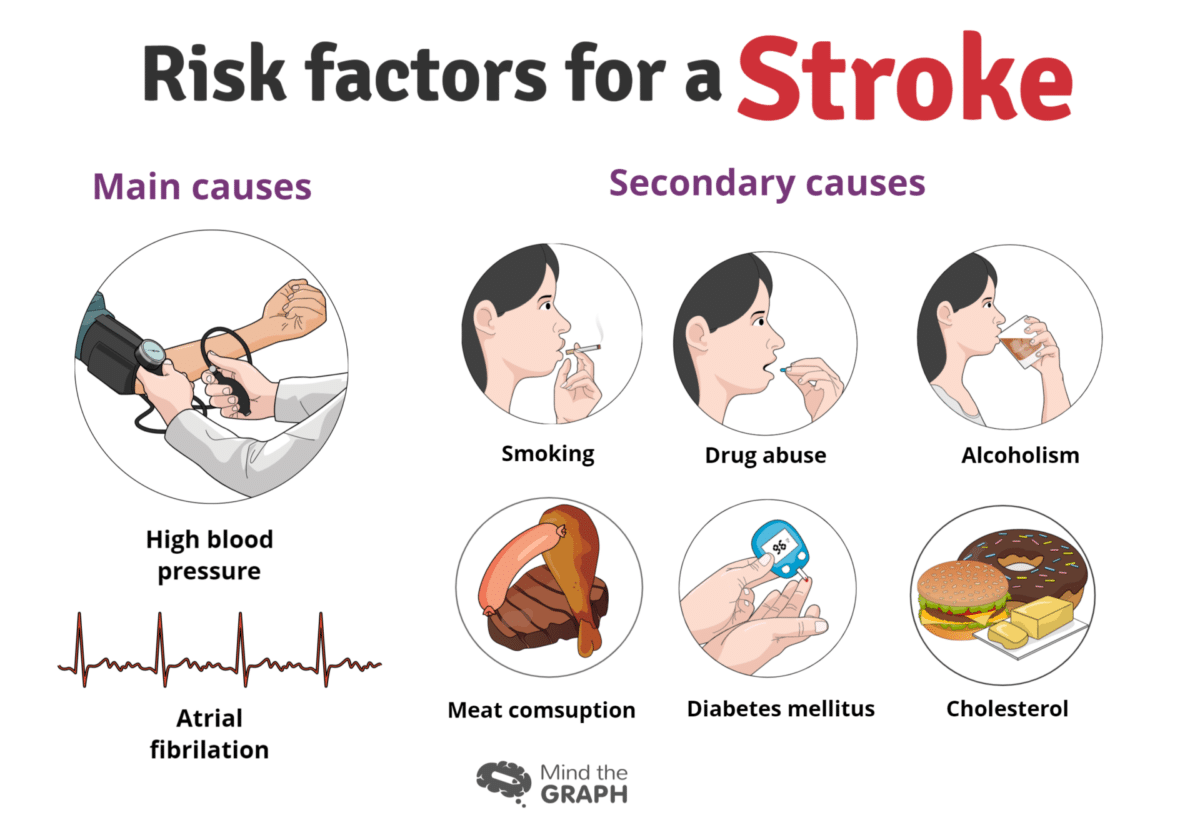Top 10 Modifiable Stroke Risk Factors
 Elyse Newland is an Occupational Therapist who loves her work but is frustrated with the state of U.S. healthcare. She works specifically with stroke survivors and continues to explore ways to route around the system to get survivors the resources they need. Elyse makes stroke information and treatment simple via her weekly blog post on her website and her weekly YouTube video. She also provides teletherapy for stroke survivors in TN, GA, NC, OR, and CA. You can find her at https://elysenewland.com/
Elyse Newland is an Occupational Therapist who loves her work but is frustrated with the state of U.S. healthcare. She works specifically with stroke survivors and continues to explore ways to route around the system to get survivors the resources they need. Elyse makes stroke information and treatment simple via her weekly blog post on her website and her weekly YouTube video. She also provides teletherapy for stroke survivors in TN, GA, NC, OR, and CA. You can find her at https://elysenewland.com/
May is Stroke Awareness Month here in the U.S. Up to 80% of strokes are preventable with lifestyle changes: that’s a big number.
Understanding the lifestyle factors you can change is the first step towards stroke prevention. If you’ve already survived a stroke, changing your lifestyle can help reduce the risk of a secondary stroke.
The Top 10
Smoking
We’ve known for years that smoking is a bad habit: this hasn’t stopped big tobacco from continuing to advertise and lobby against health-saving measures at the state and federal levels.
What makes smoking so bad for us, and how does it increase our risk for stroke?
You probably already know that smoking causes lung damage. You’re 25 times more likely to develop lung cancer if you smoke.
But what you might not know is the impact that smoking has on your blood vessels.
It can cause your vessels to narrow and your blood to thicken. Smoking can also cause damage to your blood vessels because it raises your blood pressure. It causes your heart to pump harder and faster to get blood through those narrowed vessels.
That sustained blood pressure pushing on your blood vessel walls will cause damage.
Picture a garden hose without a sprayer nozzle attached. When you were a kid, did you ever put your thumb over where the water comes out? You get a much stronger spray by narrowing the opening of where that water comes out.
That’s similar to how blood pressure works in narrowed blood vessels. The damage to your blood vessels can also cause clots to form, which we know cause 87% of all strokes.
So the treatment is clear. Stop smoking.
Committing to that is hard. Smoking is an addiction. Talk to your doctor. They may start you on patches, medications, or nicotine gum to help you start weaning yourself off tobacco products.
If you can, find a local or virtual support group who will understand the struggle you’re going through.
High Cholesterol
When we have too much cholesterol in our blood, specifically low-density lipoprotein (LDL) or “bad” cholesterol, this can cause fatty build-up in our blood vessels. These fatty deposits are known as atherosclerosis.
The build-up of fats in our blood vessels can cause narrowing, stiffening, and weakening, which can all lead to high blood pressure. Bits of fat can also break off and travel through the body. If it becomes lodged in a blood vessel in the brain, this can lead to an ischemic stroke.
If your doctor has put you on a statin to help control your cholesterol level, don’t stop taking it unless they tell you. Like with high blood pressure, there are controllable and uncontrollable components that affect the likelihood of developing high cholesterol.
With that said, there are some lifestyle modifications you can make to lower your risk. The biggest factor to decrease cholesterol level is to reduce the amount of saturated fat you eat.
Saturated fat is typically found in animal products (meat, butter, dairy, etc.) and in things like deep-fried foods and cakes/pastries. I know, all the stuff that tastes really good.
Here’s the good news: it doesn’t mean that you necessarily have to go on a low-fat diet. It means that you need to be eating better quality fats (unsaturated fats) like olive oil, avocados, nuts, and seeds. Try swapping out a few “bad” fats for “good” fats and see what you think!
High Blood Pressure
The fuss and hubbub around having high blood pressure are present for a reason. Chronically elevated blood pressure causes the walls of our arteries to weaken, narrow, and become damaged. This can cause provide an opportunity for a clot to form (leading to ischemic stroke) or a blood vessel to rupture (leading to a hemorrhagic stroke).
This also puts strain on the heart muscle. The heart has to pump more often and harder due to the need to push blood through the narrowed arteries.
Chronic high blood pressure is one of the primary causes of hemorrhagic strokes. While genetics and race/ethnicity (things you can’t change) play a role in developing high blood pressure, there are still modifiable risk factors you can work on.
The biggest lifestyle factor to change is diet. Specifically, cut back sodium in your diet.
Why?
At a chemical level, water always follows salt. When you over-consume salt, an excess amount of water follows that salt into your blood vessels. This extra fluid in your blood vessels causes increased blood pressure.
If you’re thinking about changing your diet to decrease sodium intake, check out the DASH diet or the Dietary Approaches to Stop Hypertension to get some ideas.
Diabetes
Almost 1 in 10 Americans have Type 2 Diabetes. Most people understand that diabetes results from high blood sugar (glucose), but some may not realize why it happens and how it impacts our bodies over time.
Type 2 Diabetes is known as insulin-resistant diabetes. I was watching a presentation on foods that improve brain health on YouTube by UC Davis Health. The presenter, Dr. Liz Applegate, gave an excellent analogy for Type 2 Diabetes.
She described insulin (a hormone produced by the pancreas that regulates glucose uptake) as a teacher. She compared blood glucose to students waiting in the hallway (blood vessel) to get into a new classroom (body cell). The insulin knocks on the body cell door to allow the glucose to enter.
When someone has Type 2 Diabetes, the cell doesn’t always hear the insulin knocking and won’t open the door to allow the glucose in. This results in a pile-up of glucose in the bloodstream. Dr. Applegate asked the audience to imagine what it would be like if you let a bunch of young students go crazy in the hallways of a school. You’d see damage!
When glucose builds up in our bloodstream, this can cause damage to our blood vessels, increase blood pressure, cause vessels to stiffen, and result in the build-up of fatty deposits.
If you have Type 2 Diabetes, stay on or talk to your doctor about an appropriate medication regimen. It’s also necessary to make sure you’re getting enough physical activity and eating the right foods to better manage your health condition. Your body will thank you in the long run.
Obesity
Worldwide obesity has tripled since 1975.
In 2016, 39% of the world’s adults were considered overweight.
In 2018, 73.6 % of U.S. adults were overweight or obese.
There are a lot of reasons why obesity has increased globally over the past 50 years. From 1970 to 2008, the average daily calories consumed per person increased by approximately 600 calories. Since the 1970s, the number of fast-food restaurants in the U.S. has doubled.
I bring up these statistics to share that this problem is widespread and isn’t going away anytime soon. We all know that we need to be at a healthy weight, eat healthy foods, and move more. But actually doing those things is very complicated. If it was easy, everyone would eat well, exercise often, and be at a healthy weight.
Aside from the statistics I just mentioned, there are so many factors that influence whether someone will become overweight or obese. They include genetics, the social environment and culture that a person grows up in, food availability, knowledge of diet and activity, personal psychology, and several neurohormonal cues that aren’t very well understood.
So we know that being overweight or obese is bad for our health.
But how does obesity actually impact stroke risk?
Being overweight or obese increases the risk of developing diabetes, high cholesterol, high blood pressure, atrial fibrillation (a heart rhythm disorder that can lead to stroke), and obstructive sleep apnea.
I’ve already talked about how diabetes, high cholesterol, and high blood pressure can put someone at increased risk for having a stroke. In addition to those factors, increased adipose tissue (or fat) is an active player in increasing inflammation in the body, the build-up of fatty deposits in the blood vessels, and insulin resistance.
The key to making sustainable changes is moving away from an instant gratification mindset and making small changes. When we start on a weight loss journey, it’s normal not to lose weight instantly or to hit multiple plateaus.
Weight loss is not a linear process, meaning you won’t go from point A to point B. There are ups and downs.
Making small changes is one of the best ways to start on a big journey. You could commit to swapping out one side of chips with carrots or walking a quarter-mile before moving to a longer distance.
And if you haven’t read the book Atomic Habits by James Clear, I highly recommend it. It’s backed by research and offers actionable tips on making sustainable changes.
Activity Level
We know that moving less can contribute to overweight and obesity which can lead to increased stroke risk. Instead of asking how physical activity increases stroke risk, I want to cover how physical activity benefits our minds and bodies.
Aside from keeping you looking good, regular physical activity can improve your mood. When we exercise, our bodies release endorphins, serotonin and increases dopamine production. This improves our level of happiness and can help mitigate the effects of depression.
In addition to making us psychologically feel better, regular physical activity also helps stimulate glucose uptake and the body’s sensitivity to insulin. In plain language, this means that it can help lower blood sugar.
If you have type 2 diabetes, talk to your doctor before starting a new exercise regimen. You’ll need to take certain precautions.
Regular physical activity also improves the strength of your heart. Your heart doesn’t have to work as hard to pump blood when it’s stronger. It can move more blood out with fewer pumps. This is super important as it helps increase the efficiency of your heart and will usually end up lowering blood pressure.
As I mentioned in the previous section, when you start making changes, remember that they need to be small to make them sustainable. The CDC recommends 150 minutes of moderate physical activity per week or 75 minutes of vigorous activity. But you don’t have to start at 30 minutes a day. Commit to 5 minutes, or maybe 10 jumping jacks: whatever you’re capable of doing and something that doesn’t seem too overwhelming.
Break up your activity into 5 minutes chunks through the day versus one 30 minute session. There are ways to make getting the recommended amount of physical activity much more sustainable.
Diet
What we eat also plays a big role in stroke risk. Research has been and continues to be conducted on healthy plant-based foods and their ability to reduce stroke risk. We already know that eating foods high in saturated fat and sodium can be destructive to our bodies.
As I mentioned above, saturated fats are primarily found in animal products (like butter and cheese). Saturated fats are so detrimental to our health because that they raise our LDL cholesterol or “bad” cholesterol. Increased blood cholesterol causes a build-up of fatty deposits which can lead to blockage and clot formations, ultimately increasing stroke risk
I also previously discussed sodium and its role in increasing blood pressure. Because water follows sodium, the more sodium we eat, the more water follows it into our bloodstream. The increased fluid in our blood vessels causes our blood pressure to increase. If we eat a high sodium diet all the time, our blood pressure remains chronically elevated.
So what can you do? Again, commit to small changes.
Swap out a bad quality fat for a good quality fat. For example, cook with olive oil instead of butter. Eat a serving of salmon once a week instead of red meat. Salmon is full of healthy fats and protein.
Lower the amount of added salt you add to anything you cook and choose no salt added options for prepackaged foods. Try to limit the amount you go out to eat if you can. I know it’s not feasible for everyone, but restaurants and fast food joints are notorious for adding excessive salt to their menus.
Heavy Alcohol Intake
The research keeps ping-ponging back and forth between “moderate alcohol is protective against strokes” to “alcohol intake should absolutely be avoided.”
What we do know for a fact is that drinking too much alcohol can increase our blood pressure.
The Mayo Clinic reported that chronic binge drinking can lead to elevated blood pressure, among other complications. I’ve talked about why and how increased blood pressure affects our stroke risk.
Heavy alcohol intake can also lead us to make unwise decisions. Because alcohol decreases our inhibitions, we may be more prone to reach for foods that we’re trying to stay away from, especially high fat, greasy foods.
Alcohol may also keep us from regularly engaging in physical activity due to either being drunk or hungover. No one’s going out for a 2-mile jog if they’re hungover.
It’s important to remember that alcohol can interfere with certain medications. Talk with your doctor about drinking and its impact on your medication regimen.
Stress
Stress. We all experience it in some form or another. Certain situations in our lives will cause us to feel more stressed than others. The really negative effects of stress and increased stroke risk happen when we stay in a chronic state of stress.
If we don’t know how to cope with stress, it can cause physical and mental health issues. Chronic stress increases inflammation in the body, causes our heart to work harder, and raises our blood pressure. It causes increased anxiety and depression.
Stress is problematic in its own right as we all respond differently. Some of us don’t eat at all when we’re really stressed, while others overeat. And when we overeat, we tend to reach for satiating foods that are high in fat and sugar.
These types of foods stimulate the reward centers in our brain and make us feel temporarily happy. But they don’t solve the underlying issues and subsequently, make the situation worse by increasing blood cholesterol and blood pressure.
Finding healthy ways to cope with stress is necessary to mitigate stroke risk. Engage in a fun hobby that you enjoy, spend time with loved ones, make a plan to manage stress, or reach out to a mental health therapist or counselor if you need a little extra help.
Taking Medications
The last stroke risk factor is adhering to medications. The importance of understanding what your medications are for, what your doses are, and how often to take them can’t be overstated.
By now, you know that both high cholesterol, blood pressure, and diabetes play a large role in increasing stroke risk.
You should know if you take any medications for these conditions. If you’re unsure why you’re taking any specific medications, reach out to your doctor or their nurse to clarify. Knowledge is power.
Understanding what risk factors you can change is the first step towards reducing your stroke risk. Remember, up to 80% of strokes are preventable (in the U.S.). Make a plan to reduce your risk and share this information to spread awareness.


